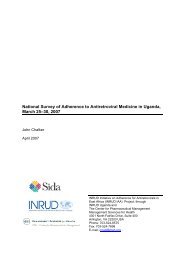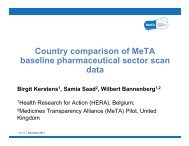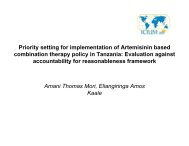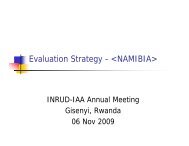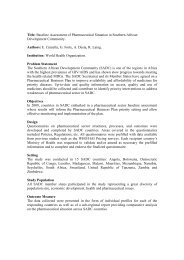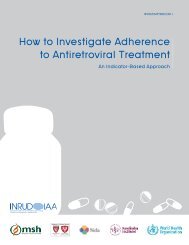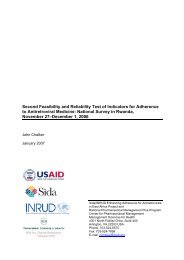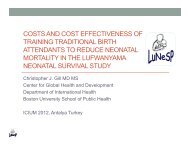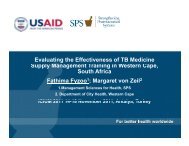Assessment of Drug Utilization Patterns in Some Health ... - INRUD
Assessment of Drug Utilization Patterns in Some Health ... - INRUD
Assessment of Drug Utilization Patterns in Some Health ... - INRUD
Create successful ePaper yourself
Turn your PDF publications into a flip-book with our unique Google optimized e-Paper software.
<strong>Assessment</strong> <strong>of</strong> <strong>Drug</strong><br />
<strong>Utilization</strong> <strong>Patterns</strong> <strong>in</strong> <strong>Some</strong><br />
<strong>Health</strong> Insurance Outpatient<br />
Cl<strong>in</strong>ics <strong>in</strong> Alexandria<br />
1Ibrahem, Samaa Zenhom; 1Amer, N.;<br />
2Ghoneim, M.; 1Abou El Ene<strong>in</strong> N<br />
1High Institute <strong>of</strong> Public <strong>Health</strong>, Egypt<br />
2Faculty <strong>of</strong> Medic<strong>in</strong>e
Problem statement: The selection and rational use <strong>of</strong> medic<strong>in</strong>es are accepted as key pr<strong>in</strong>ciples <strong>of</strong> health service<br />
quality and management <strong>in</strong> both the public and private sectors. Many researchers <strong>in</strong> develop<strong>in</strong>g countries,<br />
however, have described drug use as irrational, document<strong>in</strong>g cases <strong>of</strong> <strong>in</strong>effective, unsuitable, suboptimal or<br />
unsafe prescrib<strong>in</strong>g, supply, and/or consumption <strong>of</strong> pharmaceutical products.<br />
Objectives: To assess the pattern <strong>of</strong> drug use concern<strong>in</strong>g prescrib<strong>in</strong>g, patient care, and facility standards <strong>in</strong> the<br />
selected outpatient cl<strong>in</strong>ics <strong>in</strong> <strong>Health</strong> Insurance Organization us<strong>in</strong>g World <strong>Health</strong> Organization (WHO) core<br />
<strong>in</strong>dicators <strong>of</strong> drug use <strong>in</strong> health facilities<br />
Design: A prospective cross-sectional study design was carried out.<br />
Sett<strong>in</strong>g: The study was conducted <strong>in</strong> five randomly selected <strong>Health</strong> Insurance outpatient cl<strong>in</strong>ics <strong>in</strong> the<br />
Alexandria governorate.<br />
Study population: A random sample <strong>of</strong> 30 encounters per each physician <strong>of</strong> all 62 general practitioners, <strong>in</strong>ternal<br />
medic<strong>in</strong>e, and ENT specialists work<strong>in</strong>g <strong>in</strong> those cl<strong>in</strong>ics was carried out as recommended by WHO for studies<br />
describ<strong>in</strong>g current treatment practice, so the required sample <strong>of</strong> patients was 1,860.<br />
Results: Results <strong>in</strong>dicated that as regards prescrib<strong>in</strong>g <strong>in</strong>dicators, the overall mean number <strong>of</strong> drugs prescribed<br />
per encounter was 2.8, the overall percentage <strong>of</strong> drugs prescribed by generic name was 61.0%, the overall<br />
percentage <strong>of</strong> prescriptions conta<strong>in</strong><strong>in</strong>g antibiotics was 52.2%, the percentage <strong>of</strong> encounters where an <strong>in</strong>jection<br />
was prescribed was 20.6% overall. As regards health facility <strong>in</strong>dicators, the essential drug list was found only <strong>in</strong><br />
one cl<strong>in</strong>ic and the percentage <strong>of</strong> drugs prescribed from the list was 100.0% <strong>in</strong> that cl<strong>in</strong>ic. As regards patient care<br />
<strong>in</strong>dicators, the overall average consultation time was 3.0 m<strong>in</strong>utes, the mean time taken to dispense medications<br />
was 16.9 seconds, and the overall percentage <strong>of</strong> correct patient knowledge <strong>of</strong> dosage <strong>of</strong> prescribed drugs was<br />
69.3%. Additionally <strong>in</strong> all cl<strong>in</strong>ics, the percentage <strong>of</strong> drugs adequately labeled was 0.0%.<br />
Conclusions: It was concluded that cont<strong>in</strong>uous medical education <strong>of</strong> doctors at all levels <strong>of</strong> qualification on<br />
rational drug use should be <strong>in</strong>stituted and treatment guides and tra<strong>in</strong><strong>in</strong>g courses are recommended emphasiz<strong>in</strong>g<br />
the importance <strong>of</strong> adequate label<strong>in</strong>g and <strong>in</strong>structions to the patient.
Introduction/Background<br />
Rational drug use has <strong>in</strong>creas<strong>in</strong>gly received public policy<br />
attention <strong>in</strong> efforts to ma<strong>in</strong>ta<strong>in</strong> quality health care at lower costs.<br />
It helps to ensure that drugs are used only when they are needed,<br />
and that people understand what the medic<strong>in</strong>es are and how to<br />
use them. Therefore, rational prescription and use <strong>of</strong> drugs has<br />
been a concern <strong>in</strong> both developed and develop<strong>in</strong>g countries<br />
dur<strong>in</strong>g the last two decades and has been promoted by WHO<br />
and others.
Introduction/Background<br />
For the rational drug use, there are five important criteria <strong>in</strong>clud<strong>in</strong>g, accurate<br />
diagnosis, proper prescrib<strong>in</strong>g, correct dispens<strong>in</strong>g, suitable pack<strong>in</strong>g and patient<br />
adherence.<br />
<strong>Drug</strong> use <strong>in</strong> develop<strong>in</strong>g countries is <strong>in</strong>fluenced by many factors: health and<br />
drugs policy determ<strong>in</strong>es the legal frameworks for drug use and its regulation;<br />
the organization and processes <strong>of</strong> health care provision affect access to<br />
pr<strong>of</strong>essionals and drug therapy; also there are commonly big differences <strong>in</strong> the<br />
availability <strong>of</strong> drugs and services between regions (notably urban and rural<br />
areas). In addition, provision and uptake <strong>of</strong> care are limited by f<strong>in</strong>ancial<br />
constra<strong>in</strong>ts on the part <strong>of</strong> governments and <strong>in</strong>dividuals
Objectives/Study Questions<br />
The aim <strong>of</strong> this study is to assess the pattern <strong>of</strong> drug use<br />
concern<strong>in</strong>g prescrib<strong>in</strong>g, patient care, and facility standards <strong>in</strong> the<br />
selected outpatient cl<strong>in</strong>ics affiliated to <strong>Health</strong> Insurance<br />
Organization us<strong>in</strong>g World <strong>Health</strong> Organization (WHO) core<br />
<strong>in</strong>dicators <strong>of</strong> drug use <strong>in</strong> health facilities.
Methods<br />
Prospective cross-sectional study was conducted <strong>in</strong><br />
five randomly selected <strong>Health</strong> Insurance outpatient<br />
cl<strong>in</strong>ics <strong>in</strong> Alexandria governorate.<br />
The target population consists <strong>of</strong> a Sample <strong>of</strong><br />
patients with different health problems and different<br />
ages who attended the selected <strong>Health</strong> Insurance<br />
outpatient cl<strong>in</strong>ics dur<strong>in</strong>g the study period.
Methods<br />
A random sample <strong>of</strong> 30 encounters per each<br />
physician <strong>of</strong> all 62 general practitioners, <strong>in</strong>ternal<br />
medic<strong>in</strong>e and ENT specialists work<strong>in</strong>g <strong>in</strong> the<br />
selected cl<strong>in</strong>ics was carried out as recommended by<br />
WHO for studies describ<strong>in</strong>g current treatment<br />
practice, so the required sample <strong>of</strong> patients was 1860.
Methods<br />
In each <strong>of</strong> the selected <strong>Health</strong> Insurance outpatient cl<strong>in</strong>ics, the<br />
researcher observed 30 patients dur<strong>in</strong>g physician-encounter to collect<br />
the data related to patient care. The record<strong>in</strong>g <strong>of</strong> all prescribed drugs<br />
was done. In each physician patient encounter, time <strong>of</strong> enter<strong>in</strong>g and time<br />
<strong>of</strong> leav<strong>in</strong>g consultation room were recorded. Then, the researcher<br />
accompanied the patients to the pharmacy and recorded the time <strong>of</strong><br />
arrival and time <strong>of</strong> departure from dispensary counter. In the pharmacy,<br />
the record<strong>in</strong>g <strong>of</strong> dispensed drugs and drugs that were adequately labeled<br />
was done. Also the researcher recorded if patients know the dosage <strong>of</strong><br />
the dispensed drugs or not through <strong>in</strong>terview <strong>of</strong> observed patients<br />
regard<strong>in</strong>g their knowledge. <strong>Drug</strong> use patterns <strong>in</strong> the selected outpatient<br />
cl<strong>in</strong>ics were assessed accord<strong>in</strong>g to WHO <strong>in</strong>dicators which are classified<br />
<strong>in</strong>to three categories <strong>in</strong>clud<strong>in</strong>g: prescrib<strong>in</strong>g <strong>in</strong>dictors, patient care<br />
<strong>in</strong>dicators and health facility <strong>in</strong>dicators.
Results<br />
Socio-demographic data for study sample<br />
Male<br />
56.7%<br />
Female<br />
43.3%<br />
20-<br />
9.9%<br />
30-<br />
18.3%<br />
10-<br />
19.5%<br />
40-<br />
17.9%<br />
50-<br />
15.4%<br />
60+<br />
14.5%<br />
Less than<br />
10 years<br />
4.5%
Results<br />
Socio-demographic data for study sample<br />
Skilled worker<br />
8.6%<br />
Clerk<br />
24.2%<br />
Pr<strong>of</strong>essional<br />
9.8%<br />
Student<br />
24.0%<br />
Recurrent<br />
82.7%<br />
Non-skilled<br />
worker<br />
11.9%<br />
Housewife<br />
13.3%<br />
Retired<br />
8.1%<br />
New<br />
17.3%
Other<br />
diagnosis<br />
56.9%<br />
Upper<br />
respiratory<br />
tract<br />
<strong>in</strong>fections<br />
43.1%
Percentage<br />
Correct<br />
patient<br />
knowledge<br />
about dose<br />
<strong>Drug</strong>s<br />
adequately<br />
labeled<br />
<strong>Drug</strong>s<br />
actually<br />
dispensed<br />
<strong>Drug</strong>s from<br />
essential<br />
drug list<br />
Encounters<br />
with<br />
<strong>in</strong>jection<br />
Encounters<br />
with<br />
antibiotic<br />
<strong>Drug</strong>s by<br />
generic<br />
names<br />
100<br />
80<br />
60<br />
61<br />
52.2<br />
69.3<br />
40<br />
20<br />
20.6<br />
12.7<br />
0<br />
0<br />
Prescrib<strong>in</strong>g <strong>in</strong>dicators<br />
Patient care <strong>in</strong>dicators
Average<br />
20<br />
18<br />
16.90<br />
16<br />
14<br />
12<br />
10<br />
8<br />
6<br />
4<br />
2.80 3.00<br />
2<br />
0<br />
Average number <strong>of</strong> drugs<br />
prescribed per encounter<br />
(No.)<br />
Average consultation time<br />
(m<strong>in</strong>utes)<br />
Average dispens<strong>in</strong>g time<br />
(seconds)
Implications/Conclusions<br />
Although teach<strong>in</strong>g basic pharmacology is necessary to build<br />
knowledge, physicians urgently need systematic,<br />
comprehensive and applicable pharmacotherapy curriculum <strong>in</strong><br />
their education to develop rational prescrib<strong>in</strong>g habits.<br />
Limit<strong>in</strong>g the role <strong>of</strong> pharmaceutical companies <strong>in</strong> physician<br />
tra<strong>in</strong><strong>in</strong>g and promot<strong>in</strong>g more objective sources <strong>of</strong> <strong>in</strong>formation<br />
such as therapeutic guidel<strong>in</strong>es for common medical conditions.
Implications/Conclusions<br />
Br<strong>in</strong>g<strong>in</strong>g the essential drug list to cl<strong>in</strong>ician’s attention at the time<br />
<strong>of</strong> consultation either through availability <strong>of</strong> a hardcopy or<br />
<strong>in</strong>clusion <strong>of</strong> the list on a desk top computer will <strong>in</strong>fluence the<br />
rational use <strong>of</strong> drugs.



